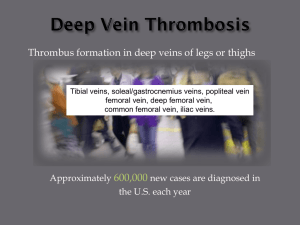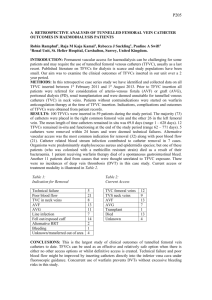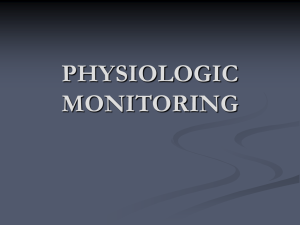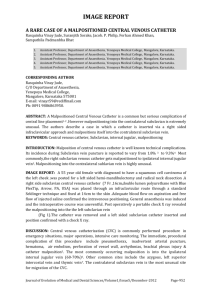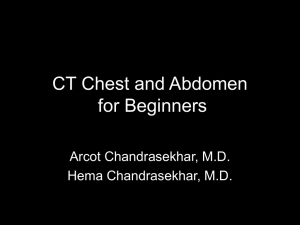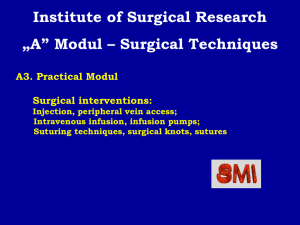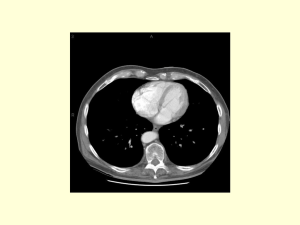Bloodstream Infections and what can be done to reduce them
advertisement
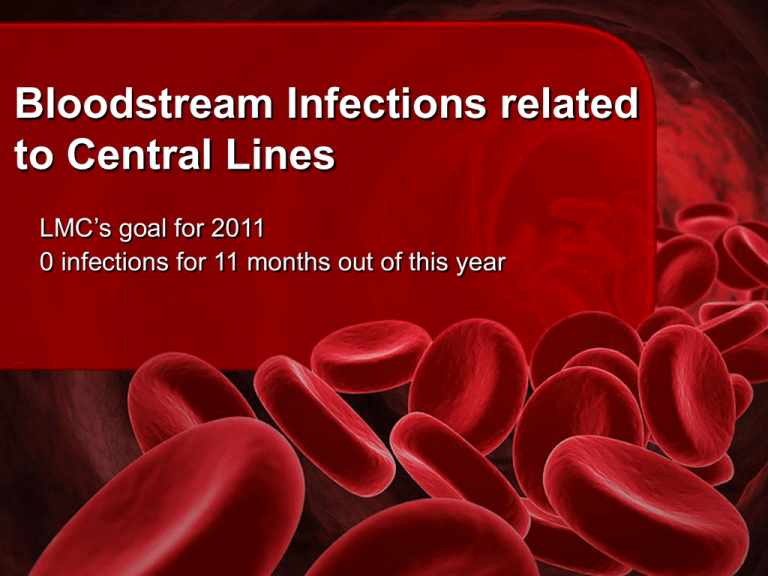
Bloodstream Infections related to Central Lines LMC’s goal for 2011 0 infections for 11 months out of this year What are the facts? • Since 2008, the CDC has published information estimating that 92,011 central line associated bloodstream infections (CLABSI’s) occur annually just in the United States. • Each case can increase hospital costs by $5,734 up to $25,546. • CLABSI’s cause an estimated 28,000 deaths in ICU patients annually. (APIC, 2009) So what can we do? • As always, we at LMC want the best outcomes for our patients. LMC has set goals for 2011 to significantly reduce any bloodstream infections. • Our central line policy and procedure has been updated to include the most recent evidence based information. • LMC is also implementing care bundling for central line insertion and care to decrease CLABSI’s. Central Line-Definition • An intravascular catheter that terminates into the inferior vena cava & used for infusion, withdrawal of blood, & or for hemodynamic monitoring (APIC, 2009). Indications for Central Lines • • • • Blood loss Hypotension Hemodialysis access Total parenteral nutrition or other hyperosmolar solutions • Lack of peripheral venous access • Infusion of medicines long-term • Volume measurements Anatomy & Physiology Veins used for Central Venous Access: – Internal jugular vein – Subclavian vein – Femoral vein – Basilic or Cephalic vein (Scales, 2010) Subclavian Vein • Subclavian vein is a continuation of the axillary vein and then joins the internal jugular vein to become the innominate vein. – In front of the clavicle. – Behind and above the subclavian artery and separated medially by the Scalenus anterior and the phrenic nerve. – Below it sits at the first rib and the pleura (Gray, 2000, para 15). Internal Jugular Vein – The internal jugular vein receives blood from the brain, the superficial parts of the face, and the neck and has its origin at the compartment of the jugular foramen, at the base of the skull. • Glossopharyngeal & hypoglossal nerves pass forward between the vein and artery. • Vagus nerve is between and behind the internal jugular vein and artery in a common sheath. Internal Jugular Vein (cont) • It runs in vertical direction on the side of neck. – Lateral to internal carotid artery – Lateral to common carotid – Unites with subclavian vein to become the innominate vein. Internal Jugular Vein (cont) – At origin and termination there is a small dilation bulb – Above, internal jugular lies on Rectus capitis lateralis, behind internal carotid artery and nerves passing through jugular foramen – At the root of the neck, the right internal jugular vein, there is very little distance from the common carotid artery and crosses the beginning of the subclavian artery. – Left vein usually smaller than the right (Gray, 2000, para 6). Femoral Vein “The neurovascular bundle consists of the femoral vein, artery, and nerve, and lies within the triangle in a medial-to-lateral position. The femoral sheath encloses the femoral artery and vein, and the nerve lies outside the sheath…Distally in the leg, the femoral vein lies almost posterior to the artery” (Pal, 2009, para 6-9). Basilic Veins • Runs up the posterior surface of the ulnar side of the forearm. http://www.learnerhelp.com/images/cubital%20fossa%202.JPG The Best Site ? • Subclavian vein may have lower risk of central line-associated bloodstream infection (CLBSI) – Increased risk of pneumothorax – Increased bleeding • Internal jugular vein less risk of pneumothorax – Disadvantage with obese patients • Femoral vein increased risk of infection and deep venous thrombosis in adults – Hematoma – Femoral artery puncture • Basilic vein increased risk of thrombosis (Wiegand & Carlson, 2005) Types of Catheters • Nontunneled catheters indicated for short-term use • Tunneled catheters • Implanted catheters (ports) • Peripheral inserted central catheters (PICC) Tunneled Catheters • Associated with lower infection rates than nontunelled • More complex insertion and removal • Indicated for chemotherapy, antibiotics, parenteral feeding, blood products, and frequent blood draws • Long-term (>30 days) central venous access • With and without Dacron anchoring cuffs Non-Tunneled Catheters • Large-bore catheters – 6-8 in. long • One to four lumens • Short-term (<10 days) central venous access • Highest risk of infection • Easy to insert and remove Implanted Ports • Lowest rates of CLBSI • Surgical insertion and removal • Long-term intermittent therapy. • No external catheter • Low maintenance PICC • Ambulatory or outpatient therapy • Easy to insert and remove • Longevity • Incidence of malposition greater What is care bundling? • “Care bundles, in general, are groupings of best practices with respect to a disease process that individually improve care, but when applied together result in substantially greater improvement” (www.ihi.org). • Evidence based research on care bundling has shown positive impact. Central Line Bundle • Defined as “A group of evidence-based interventions for patients with intravascular central catheters that, when implemented together, result in better outcomes than when implemented individually” (www.ihi.org). Central Line Insertion Bundle • Cleanse hands (ask if unsure) • Use chlorhexidine • • Use maximal barrier precautions – Wear sterile gloves, cap, mask, & gown (for the physician placing the central line) – Large drape to cover patient All personnel in room wear a mask Central Line Maintenance Bundle • Review daily for continuous need • Maintain occlusive dressing • Change dressing per hospital protocol • Scrub hub for minimum of 15 seconds prior to accessing the line • Hand hygiene before & after procedure • Performing each bundling step in order when either assisting with a central line insertion or caring for a central line will help to reduce your patient’s risk for infection. Instructional Video http://lexloop/videopages/Central_line_dressing_change2010.html Right click on link above and choose “open in new window”. This will allow you to return to the PowerPoint after viewing video. Another Safety Feature with Central Lines • In dealing with central line and patient safety – another concern is making sure you as the practitioner are certain of the type of central line placed. • LMC has an increasing number of patients presenting with ports that are power-rated and there are special needs to be considered. PowerPort Implanted Infusion Devices • Implanted ports that are PowerPorts or power-rated (able to withstand higher psi, such as with CT contrast) have to be identified using specific criteria. • It can be very detrimental to mistake these devices and use with too much psi with a non power-rated port. Patient safety is our utmost focus here. Power Port • Power needles for power ports will only be used when the RN is able to verify that the port in place is in fact a power port. • Verification must be done as follows: – The patient has a card/ documentation verifying that it is a power port. – The patient’s medical record indicates they have a power port. • Note: Verbalization from the patient is not acceptable confirmation. If documentation not available • If the RN is unable to verify the port as a power port through acceptable documentation, then only the Huber Plus Safety needle will be used. • Again one of the two documentation criteria provided must be present to access port with a power needle. THANK YOU!!! • Again quality patient outcomes are our focus at LMC. • Thank you for taking time to put patient safety first. References • APIC. (2009). Guide to the elimination of catheter-related bloodstream infections. Washington: APIC. • Gray, H. (2000). The veins of the neck. In W. H. Lewis (Ed.), Anatomy of the human body. Retrieved from http:/www.bartleby.com/107/168.html (Original work published 1918) • Implement the Central Line Bundle (nd) Institute for Healthcare Improvement. Retrieved from www.ihi.org. • Pal, N. (2009, April). Central Venous Access,Femoral Vein. Emedicine. Retrieved from http://emedicine.medscape.com/article/80279-overview • Scales, K. (2010). Central venous access devices part 1:Devices for acute care. British Journal of Nursing,19(2), 88-92. Retrieved from CINAHL Plus with Full Text • Wiegand, D. & Carlson, K. (2005). AACN Procedure manual for critical care. St. Louis: Elsevier Saunders.
